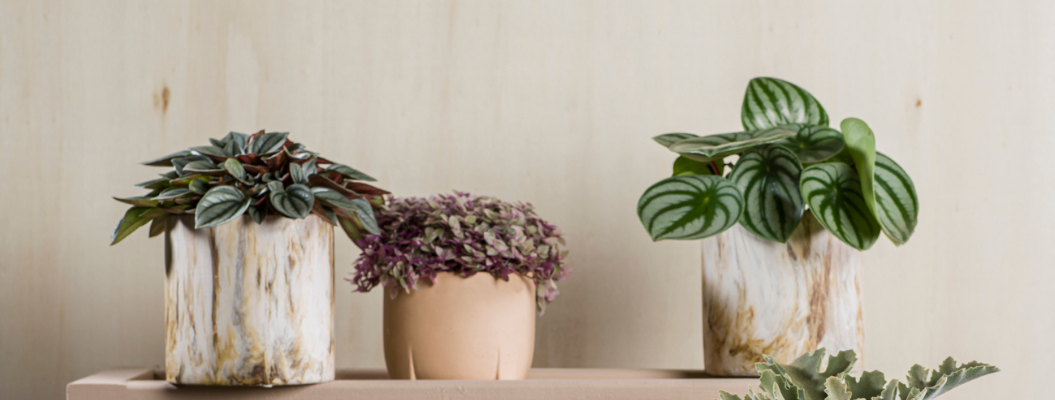Originally appeared in the Nation Garden Bureau
Why Grow Peperomias?
Peperomias are part of the Piperaceae plant family which contains a number of delightful and popular houseplants. Commonly called “Radiator Plant”, there are more than 1500 species of Peperomia with most of them hailing from tropical Central and South America.
How to Take Care of Your Peperomia Plant
Light
All Peperomia plants will enjoy a nice, bright window with mostly indirect light. Place your plants right in front of a window for best results. Although some Peperomia plants can tolerate lower light, they will eventually start to decline and growth will be very poor.
Don’t be afraid to give your plants some direct sun, as long as you are not placing your plant in direct sun for too long. Approximately 2-3 hours of morning or afternoon sunshine can be very beneficial for your plant, especially during wintertime.
Water
Because they are semi-succulent in nature, allow your Peperomia’s potting mix to dry out somewhat between watering. As a general rule of thumb for all Peperomias, allow at least the top quarter of the potting mix to dry out before watering again.
Some species are more drought tolerant than others, and I review more details on soil moisture for specific species at the end of this post.
Of all the popular species grown indoors, just be careful with Peperomia caperata. This one is the least forgiving when its soil dries out completely (the plant will quickly droop). Most of the other Peperomia species are much more forgiving and can tolerate drying out completely, as long as it’s not for terribly long.
Temperature & Humidity
Average indoor temperatures are perfectly fine for your Peperomias. Since most hail from subtropical to tropical areas, avoid cold temperatures. 65-75F will be a comfortable range for your plants.
Like any plant, avoid any cold or hot drafts from any vents in your home, and stay away from any doors that are constantly opening and closing during cold weather.
Average indoor humidity will also suffice for most Peperomia plants, but it can be beneficial to increase humidity, especially if you have exceedingly dry indoor air which is typical of homes with forced air heat.
Potting Mix & Pots
A well-draining potting mix is a must. Consider adding some perlite or pumice to an all-purpose potting mix in order to increase drainage. Everyone’s indoor conditions are different, but you can try experimenting with 3 parts of an all-purpose potting mix with 1 part perlite or pumice and adjust from there if needed. Adding more perlite or pumice will help your mix drain better and dry out faster.
Peperomia do not have large, deep root systems so avoid over-potting your plants, otherwise, the large volume of soil can take too long to dry out and increase the risk of root rot, depending on your conditions.
If your plant is root-bound and needs a larger pot, only go up by one-pot size and no larger. For example, if you have a plant growing in a 4-inch diameter pot, go up to a 6-inch diameter pot only and no bigger.
To learn more about Peperomias, visit our Year of the Peperomia and Peperomia photo library.
Popular Peperomia Varieties
There are many species of Peperomia you can purchase, but here are some of the most popular, along with some specific, helpful tips on each.
Peperomia obtusifolia – Baby Rubber Plant
This species gets my vote for the easiest Peperomia to grow. It is native to Florida, Mexico, Central & South America. If you have never grown any Peperomia, this is a great one to start with.
They can dry out completely with no complaints, making them perfect for the slightly neglectful indoor gardener. This is a non-trailing Peperomia and has pretty stiff upright growth. It will ultimately get between 1-2 feet tall in good conditions.
Peperomia argyreia – Watermelon
It is easy to see why this Brazilian native is commonly called Watermelon Peperomia. The leaves look strikingly similar to the rind of watermelon, and the plant is clump-forming.
Try and be careful to not let this one dry out completely before watering again. The entire plant will start to droop and weaken. It is not a drought-tolerant Peperomia like the obtusifolia species.
Peperomia tetragona – Parallel
Sometimes known as Peperomia puteolata, this delightful trailing Peperomia is native to Bolivia, Brazil, Ecuador, Paraguay, and Peru.
My own plant is growing in a hanging pot and has gotten over 6 feet long. If they get too long for your liking, you can cut them back and use the cuttings to propagate.
Peperomia prostrata – String of Turtles
This Ecuadorian native is another trailing species whose small, round foliage has markings that resemble turtle shells.
Allow, at most, the top quarter of the potting mix to dry out, but do not allow all of the potting mix to dry out for this species otherwise, it will quickly develop brown leaves and drop plenty of leaves.
Peperomia caperata – Ripple
This Brazilian rainforest native has beautiful, quilted, and rippled leaves. This compact, non-trailing Peperomia is great for smaller spaces.
Just be careful to not let this one dry out completely because the plant will quickly droop and collapse in a pretty dramatic fashion.
No houseplant collection should be complete without one or two Peperomias, so if you haven’t tried one, what are you waiting for?
Written By: Raffaele Di Lallo
Author: Houseplant Warrior: 7 Keys to Unlocking the Mysteries of Houseplant Care
“This post about Peperomias is provided as an educational/inspirational service of the National Garden Bureau and our members. Please credit and link to National Garden Bureau and author member when using all or parts of this article.”











